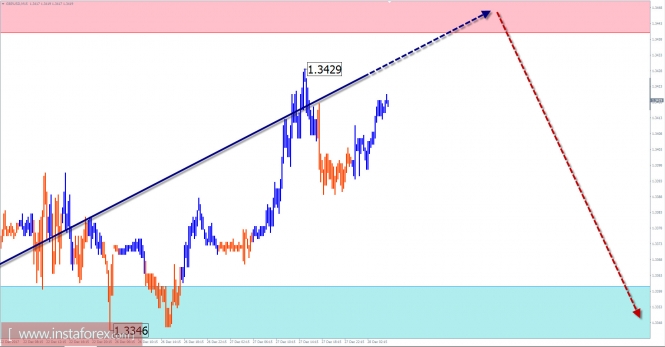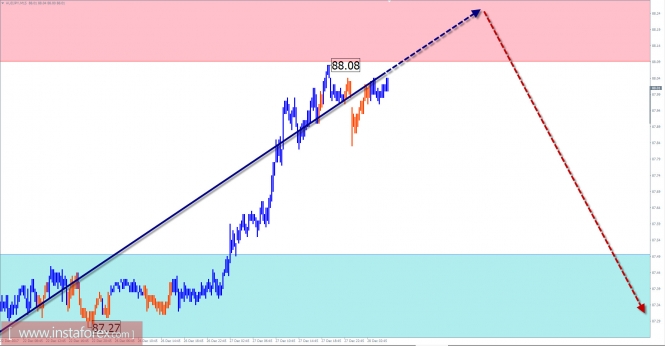
Review and forecast for GBP / USD pair
The rising price trend of the British pound major pair continued throughout this year. To date, quotes have approached the lower boundary of a wide section of the potential reversal. The zone was strengthened by the resistance level of the largest scale of the chart.
The last incomplete wave design began on September 15. This downward wave has a high wave potential and the middle part (B) is nearing completion in its structure at the time of analysis. Before changing the inter-week course, the construction lacks the final lift.
Today, the pair is expected to move within the flat price corridor formed in recent weeks. An upward mood is likely to occur in the morning but a short-term breakout of the upper boundary resistance zone is included. Closer to the end of the day, a reversal and the beginning of a decline are expected.
Boundaries of resistance zones:
- 1.3440 / 70
Boundaries of support zones:
- 1.3360 / 30

Review and Forecast for AUD / JPY pair
The 4-hour chart of the AUD/JPY cross currency pair shows the latest wave design from September 21.In this bearish wave from mid-November, the middle corrective part is actively forming.
At the time of analysis, the price reached the pre-completion zone, where there is a large scale resistance level. The price must be worked out counter-rollback even with the option of further extending the wave.
Today, we expect a more flattened mood of price fluctuations. After an attempt to break down the resistance zone, a change in the motion vector and the course of the price downward are expected. The last phase will most likely take place at the end of the day. It is possible that the time will be offset in the next trading day.
Boundaries of resistance zones:
- 88.10 / 40
Boundaries of support zones:
- 87.50 / 20

Explanations of the figures:
For simplified wave analysis, a simple waveform is used that combines 3 parts namely A, B, and C. All types of correction are created and most of the impulses can be found in these waves. Every time frame is considered and the last incomplete wave is analyzed.
The areas marked on the graphs indicate the probability of a change in the direction of motion has significantly increased as calculated in the areas. Arrows indicate the wave counting following the technique used by the author. A solid background of the arrows signifying the structure has been formed while the dotted one means the expected wave motion.
Attention: The wave algorithm does not take into account the duration of the movement of tools in time. The forecast is not a trading signal! To conduct a bargain, you need to confirm the signals used by your trading systems.